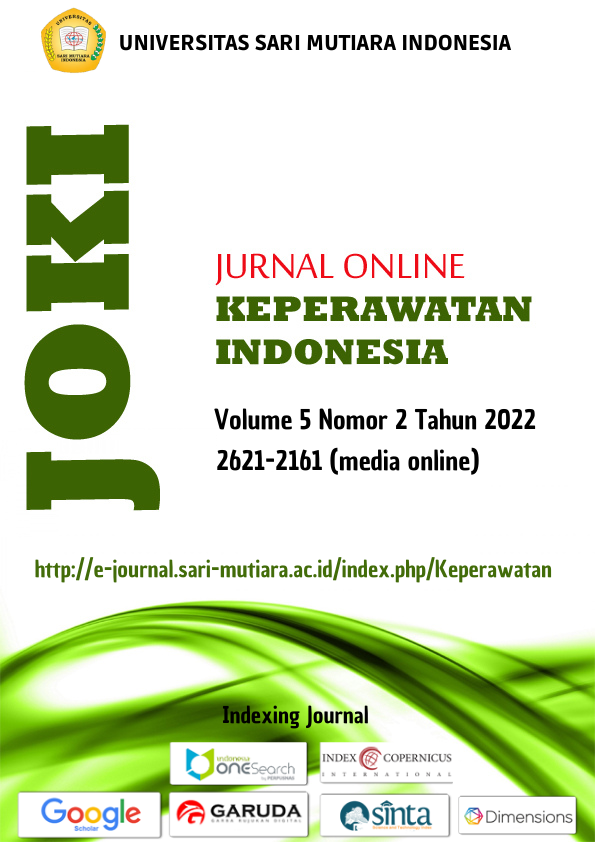PENGARUH EFFLEURAGE MASSAGE TERHADAP NYERI PERSALINAN KALA I FASE AKTIF
DOI:
https://doi.org/10.51544/keperawatan.v5i2.3501Keywords:
Labor pain, Effleurage MassageAbstract
Labor pain is something that is commonly felt by pregnant women just before the birth process. But if it is not treated with proper pain management, it will cause problems, one of which is the emergence of anxiety, stress, and feelings of worry. For this reason, it is necessary to have labor pain management, one of which is with Effleurage Massage. The study aimed to determine the effect of Effleurage Massage on Labor Pain during the Active Phase I in the Independent Midwife Practice (PMB) in Hasna Dewi, Pekanbaru City. This type of research is pre-experimental with two group pretest and posttest designs. The time of research was carried out in August-November 2022. The sample in this study was 10 respondents using a total sampling technique. The research instrument used a Numerical Rating Scale (NRS) questionnaire. Univariate and bivariate data analysis. Univariate results showed pain before being given effleurage massage moderate pain with a percentage of 90.0%. pain after being given effleurage massage pain decreased to mild pain with a percentage of 90.0%. The results of the Wilcoxon Rank Test showed that there was an effect of effleurage massage on pain in the active phase of the first stage of labor with a P value of 0.002 <0.05. The conclusion is that there is an effect of effleurage massage on pain in the first active phase of labor. It is recommended for health workers to be able to use effleurage massage to reduce pain in the active phase of labor during the first stage.
Downloads
References
Dinas Kesehatan Provinsi Riau. (2019). Profil Kesehatan Provinsi Riau Tahun 2019 (Jajuli, A (ed.)). Dinas Kesehatan Provinsi Riau.
Indrayani, & Djami, M. E. U. (2013). Asuhan Persalinan dan Bayi Baru Lahir (1st ed.). Trans Info Media.
Judha, M., Sudarti, & Fauziah, A. (2012). Teori Pengukuran Nyeri & Nyeri Persalinan (1st ed.). Nuha Medika.
Lubis, D. S. (2018). Hubungan pengetahuan Ibu Dengan Riwayat Persalinan Sectio Caesarea (SC) di RSIA Norfa Husada Bangkinang Tahun 2018. Jurnal Doppler Pahlawan Tuanku Tambusai, 2(2), 62–69. Https://journal.universitaspahlawan.ac.id/index.php/doppler/article/view/198
Safitri, Y. (2017). Perbandingan Efektifitas Massage Dan Kompres Hangat Terhadap Nyeri Persalinan Kala 1 Fase Aktif. Jurnal Ners Universitas Pahlawan Tuanku Tambusai, 1(2), 52–57. Https://journal.universitaspahlawan.ac.id/index.php/ners/article/view/117/86
Sihombing, N., Saptarini, I., & Putri, D. S. K. (2017). The Determinants Of Sectio Caesarea Labor In Indonesia (Further Analysis Of Riskesdas 2013). Jurnal Kesehatan Reproduksi, 8(1), 63–75. Https://doi.org/10.22435/kespro.v8i1.6641.63-75
Sukmawati. (2019). Pengaruh Massage Efflurage Terhadap Tingkat Nyeri Kala I Fase Aktif Di Puskesmas Bara Baraya Makassar. JIKKHC, 03(02), 1–6.
Wulandari, P., & Hiba, P. D. N. (2015). Pengaruh Massage Effleurage Terhadap Pengurangan Tingkat Nyeri Persalinan Kala I Fase Aktif Pada Primigravida Di Ruang Bougenville RSUD Tugurejo Semarang. Jurnal Keperawatan Maternitas, 3(1), 59–67.
Downloads
Published
How to Cite
Issue
Section
License
Copyright (c) 2022 JURNAL ONLINE KEPERAWATAN INDONESIA

This work is licensed under a Creative Commons Attribution-ShareAlike 4.0 International License.









.png)


